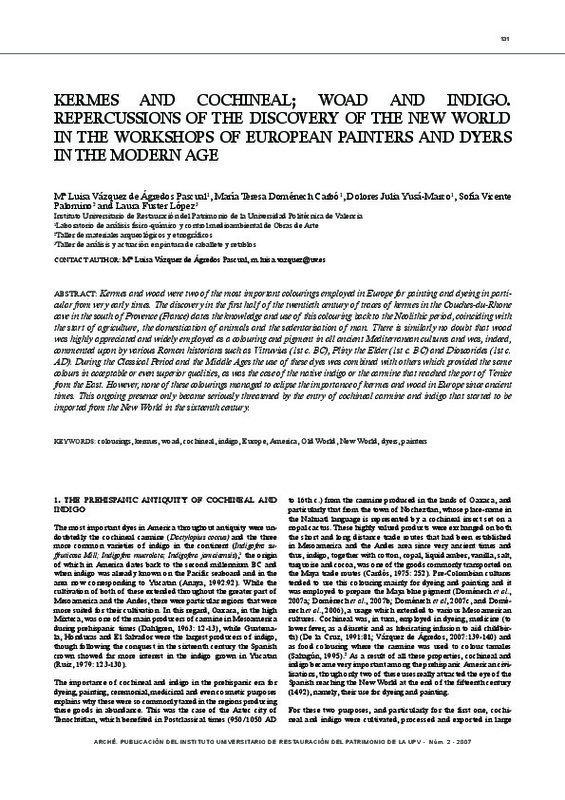JavaScript is disabled for your browser. Some features of this site may not work without it.
Buscar en RiuNet
Listar
Mi cuenta
Estadísticas
Ayuda RiuNet
Admin. UPV
Kermes and cochineal; woad and indigo. Repercussions of the discovery of the new world in the workshops of european painters and dyers in the modern age
Mostrar el registro completo del ítem
Vázquez De Agredos Pascual, ML.; Domenech Carbo, MT.; Yusa Marco, DJ.; Vicente Palomino, S.; Fuster López, L. (2007). Kermes and cochineal; woad and indigo. Repercussions of the discovery of the new world in the workshops of european painters and dyers in the modern age. Arché. (2):131-136. http://hdl.handle.net/10251/32256
Por favor, use este identificador para citar o enlazar este ítem: http://hdl.handle.net/10251/32256
Ficheros en el ítem
Metadatos del ítem
| Título: | Kermes and cochineal; woad and indigo. Repercussions of the discovery of the new world in the workshops of european painters and dyers in the modern age | |
| Otro titulo: |
|
|
| Autor: | Vázquez de Agredos Pascual, María Luisa | |
| Entidad UPV: |
|
|
| Fecha difusión: |
|
|
| Resumen: |
Kermes and woad were two of the most important colourings employed in Europe for painting and dyeing in particular from very early times. The discovery in the first half of the twentieth century of traces of kermes in the ...[+]
El kermes y el pastel fueron dos de los colorantes más importantes que se utilizaron en Europa desde tiempos muy antiguos para el teñido y la pintura, en especial para el primero de ellos. El descubrimiento que se hizo en ...[+]
|
|
| Derechos de uso: | Reserva de todos los derechos | |
| Fuente: |
|
|
| Editorial: |
|
|
| Tipo: |
|
recommendations
Este ítem aparece en la(s) siguiente(s) colección(ones)
-
Arché - Nº 02 : 2007 [27]







